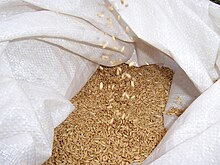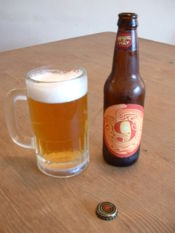Adjuncts
This articleneeds additional citations forverification.(June 2009) |

In brewing,adjunctsare unmalted grains (such asbarley,wheat,maize,rice,rye,andoats[1]) or grain products used in brewingbeerwhich supplement the mainmash ingredient(such asmalted barley). This is often done with the intention of cutting costs, but sometimes also to create an additional feature, such as better foam retention, flavours or nutritional value or additives. Both solid and liquid adjuncts are commonly used.
Definition
[edit]Ingredients which are standard for certain beers, such as wheat in awheat beer,may be termed adjuncts when used in beers which could be made without them — such as adding wheat to apale alefor the purpose of creating a lasting head. The sense here is that the ingredient is additional and strictly unnecessary, though it may be beneficial and attractive. Under theBavarianReinheitsgebotpurity law it would be considered that an adjunct isanybeer ingredient other than water,barley,hops,andyeast;this, however, is an antiquated view. This purity law originated in 16th-century Germany and did not initially include yeast due to the fact that it had not been discovered yet.[citation needed]
The term adjunct is often used to refer tocorn,rice, oats, unmalted barley and rye. The use of ingredients as substitutes for the main starch source is where the term adjunct is most often used.
Types of adjuncts and adjunct products
[edit]Adjuncts can be broadly classified according to the physical form in which they are used into solids and liquid syrups.
- Solid adjunctsare either starchy adjuncts which need to be converted to simpler sugars, or solid sugar adjuncts which can be added after conversion. Solid starchy adjuncts are normally produced from cereals and are used in the form of flakes, grits,flouror purified starch and must be added before themash tunto convert thestarchintosimple sugarswhich the yeast can use during fermentation. Cereals with a higher gelatinisation temperature than the standard mashing temperatures must be cooked in a cereal cooker to gelatinise the starch before adding to the mash. Solid sugar adjuncts include granulated sugar and glucose chips.
- Liquid adjunctsare either sucrose syrups or syrups from a grain (maize, rice or wheat), are added directly to the wort kettle and therefore can be used to reduce loading[clarification needed]on the mash andlauter tunand effectively increase the brewhouse capacity. Liquid adjuncts may also be added after fermentation as primings sugars to give sweetness to the beer for secondary fermentation as in cask orbottle conditioning.
Sources of starch adjuncts
[edit]Barleyis used as an un-malted grain at up to 10% of the grist. Barley provides both carbohydrates and proteins to the wort; on the negative side, the cell walls of the un-malted barley contain high levels ofbeta-glucansthat affect wort viscosity and create haze problems in the bright beer. Barley is also used in the mash as roasted barley to provide colour to the beer.
Cassavais a novel adjunct used in Africa either as a wet cake or as a purified starch.[citation needed]
Cornis commonly used in the production of American-style pale lagers, particularlymalt liquor.Corn is generally used in brewing ascorn syrup,and as such is highly fermentable. Corn is cheaper than barley, so it is used as a cost-saving measure.
Oatsare used inoatmeal stouts.Oatmeal stouts usually do not specifically taste of oats. The smoothness of oatmeal stouts comes from the high content of proteins, lipids, andgumsimparted by the use of oats. The gums increase the viscosity and body adding to the sense of smoothness.[2]
Rice is sometimes used in the production ofpale lagers,most notablyAnheuser-Busch'sBudweiser.Anheuser-Busch is the largest North American buyer of U.S. rice.[3]Rice may be used to lighten the body and the mouthfeel, or increase alcohol content, or add a little sweetness.
Ryeis used inroggenbiersfrom Germany and in rye beers from America. Rye is notoriously difficult to brew with, so most rye beers only include a small amount of rye.[citation needed]Rye provides a spicy flavour to beer and dramatically increases head formation.
Sorghumis used inAfricaas a local ingredient saving on expensive imported malt and developing the local agricultural sector. Sorghum has a high gelatinisation temperature and is added to a mash cooker to gelatinise the starch before adding to the mash tun. Sorghum has been used for hundreds of years as the main ingredient in many of the indigenous traditionalAfrican beers.Sorghum can be used in the malted or the un-malted form.
Wheat is used inGermanand American wheat beers, inlambicand other Belgian ales, and in English ales. Wheat lightens the body, improves head retention, and provides a tart flavour. Wheat beers are often served with fruit syrups or slices of lemon in the US and Germany.
Sugar adjuncts
[edit]Sugar adjuncts provide only carbohydrates and if used at high levels will result in wort lacking in amino acids and this may lead to poor yeast growth causing tailing fermentations and poor yeast crops.
Primings sugars such asmaple syrup,honey,andmolassesare common in craft beers and homebrew.
Candi sugaris a common ingredient in strongBelgian ales,where it increases the beer's strength while keeping the body fairly light; dark varieties of candi sugar also affect the colour and flavour of the beer.
Caramelsyrup is used to provide colour to brews and can either be added in the wort kettle or at filtration when needed to correct low beer colours. This caramel is not sweet and provides little or no fermentable extract.
Grain syrups(primarily corn syrup in North America) may be made from maize, wheat, rice or sorghum and are normally added in the wort kettle during the boil. The carbohydrate profile of these syrups may be tailored to suit the brewers' requirements and normally have a fermentability of between 70 and 100%. Typically these syrups are 74 to 80%w/wextract.
Honeyis a primary fermentable inmead,and can be used for flavour (though also supplying some fermentable sugar) in beer.
Sucrosemay come from sugar-cane or from sugar-beet.
Flavourings
[edit]A number of traditional beer styles are brewed withspices.For example, Belgianwitbieris brewed withcoriander,Finnishsahtiis brewed withjuniperberries, and traditional beers in Britain are brewed with honey and spices. Also, some strong winter beers are flavoured withnutmegorcinnamon,whilegingeris a popular flavouring for a range of beers. Many commercially available pumpkin ales are made withpumpkin piespices without any actual pumpkin.
Spices may be added to thewortduring the boil or spices or spiceextractmay be added at any time during fermentation depending on desired results.
Spices used in brewing include:
- Allspice
- Anise
- Cinnamon
- Clove
- Coriander
- Ginger
- Hot pepper
- Juniperberries or boughs
- Licorice
- Nutmeg
- Orange or Lemon peel
- Spruceneedles or twigs(seespruce beer)
- Wormwood
- Yarrow
Other, less common flavourings include chocolate, coffee, milk,chili peppersand evenoysters.
Fruit or vegetable
[edit]
Beer may be brewed with a fruit or vegetable adjunct or flavouring.
- Fruit flavouring and adjuncts
Fruits have been used as a beer adjunct or flavouring for centuries, especially with Belgianlambicstyles.Cherry,raspberry,andpeachare a common addition to this style of beer. Modern breweries may add only flavoured extracts to the finished product, rather than actually fermenting the fruit.
- Vegetable flavouring and adjunct
Pumpkin-flavoured beers are brewed seasonally in the autumn in North America.
Chile pepperis used to flavourpale lagers.
See also
[edit]References
[edit]- ^Goldammer, Ted. "6: Beer Adjuncts (selected excerpts)".The Brewers' Handbook.Archived fromthe originalon 2008-05-11.
- ^Galante, Stephan (October 1997)."Brew Your Own: The How-To Homebrew Beer Magazine - Beer Styles - Oatmeal Stout".byo.Archived fromthe originalon 2011-11-09.Retrieved2011-11-28.
- ^"Budweiser ingredients".Archivedfrom the original on 2006-08-30.Retrieved2006-08-30.
